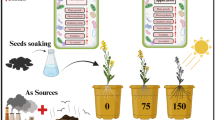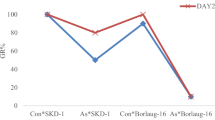Abstract
Excessive accumulation of cadmium (Cd) in vegetables poses a serious threat to human health; therefore, it is urgent to screen and cultivate vegetable cultivars with low Cd accumulation in the edible parts. Eggplant has a high tendency for Cd accumulation, but research on its low Cd accumulation cultivars is still rare. In this study, to screen low-Cd cultivars, 30 eggplant cultivars were screened using soils containing 0.22 mg/kg, 2.9 mg/kg (low-Cd), and 4.7 mg/kg of Cd (high-Cd). MYCQ and ZGQ were confirmed as low-Cd cultivars, BXGZ and WCCQ were confirmed as high-Cd cultivars, and a 2.52–3.88-fold difference in Cd concentration was observed in their fruits. The subcellular distribution revealed that the root cell wall and vacuole Cd concentrations of a typical low-Cd cultivar (MYCQ) were significantly higher than those of a typical high-Cd cultivar (BXGZ); however, the Cd concentrations in the cell wall and vacuole in fruits, leaves, and stems were significantly lower in MYCQ than in BXGZ. These results indicated that the low-Cd cultivars of eggplant could lessen Cd toxicity through the elevated Cd retention and sequestration levels of root cell walls and vacuoles, thus reducing Cd transport from roots to aboveground tissues, leading to low Cd accumulation. The findings of this study can provide a physiological and biochemical foundation for the screening and breeding of low-Cd cultivars of fruit vegetables and demonstrates that the application of low-Cd cultivars is necessary for food safety in humans.
Graphical abstract






Similar content being viewed by others
Data availability
The data of this study are available on request from the corresponding author.
References
Borges KLR, Salvato F, Loziuk PL, Muddiman DC, Azevedo RA (2019) Quantitative proteomic analysis of tomato genotypes with differential cadmium tolerance. Environ Sci Pollut Res Int 26:26039–26051
Carvalho MEA, Castro PRC, Azevedo RA (2020) Hormesis in plants under Cd exposure: from toxic to beneficial element? J Hazard Mater 384:121434
Deng F, Yu M, Martinoia E, Song WY (2019) Ideal cereals with lower arsenic and cadmium by accurately enhancing vacuolar sequestration capacity. Front Genet 10:322
FAO (2019) 'General standard for contaminants and toxins in food and feed', FAO. http://www.fao.org/fao-who-codexalimentarius/sh-proxy/en/?lnk=1&url=https%253A%252F%252Fworkspace.fao.org%252Fsites%252Fcodex%252FStandards%252FCXS%2B193-1995%252FCXS_193e.pdf
FAOSTAT (2020) FAO Statistical Database. Accessed December 22. http://www.fao.org/faostat/en/#data/QC
Feng R, Lei L, Su J, Zhang R, Zhu Y, Chen W, Wang L, Wang R, Dai J, Lin Z, Li Y, Liu B, Fan Z, Liu H, Rensing C (2020) Toxicity of different forms of antimony to rice plant: effects on root exudates, cell wall components, endogenous hormones and antioxidant system. Sci Total Environ 711:134589
Grant CA, Clarke JM, Duguid S, Chaney RL (2008) Selection and breeding of plant cultivars to minimize cadmium accumulation. Sci Total Environ 390:301–310
Greger M, Löfstedt M (2004) Comparison of uptake and distribution of cadmium in different cultivars of bread and durum wheat. Crop Sci 44:501–507
Guo JJ, Tan X, Fu HL, Chen JX, Lin XX, Ma Y, Yang ZY (2018) Selection for Cd pollution-safe cultivars of Chinese kale (Brassica alboglabra L. H. Bailey) and biochemical mechanisms of the cultivar-dependent Cd accumulation involving in Cd subcellular distribution. J Agric Food Chem 66:1923–1934
He L, Hu W, Wang X, Liu Y, Jiang Y, Meng Y, Xiao Q, Guo X, Zhou Y, Bi Y, Lu Y (2020) Analysis of heavy metal contamination of agricultural soils and related effect on population health-a case study for East River Basin in China. Int J Environ Res Public Health 17
He CT, Zhou YH, Huang YY, Fu HL, Wang XS, Gong FY, Tan X, Yang ZY (2018) Different proteomic processes related to the cultivar-dependent cadmium accumulation of Amaranthus gangeticus. J Agric Food Chem 66:1085–1095
Huang YY, Mu YX, He CT, Fu HL, Wang XS, Gong FY, Yang ZY (2018) Cadmium and lead accumulations and agronomic quality of a newly bred pollution-safe cultivar (PSC) of water spinach. Environ Sci Pollut Res Int 25:11152–11162
Huang YY, Shen C, Chen JX, He CT, Zhou Q, Tan X, Yuan JG, Yang ZY (2016) Comparative transcriptome analysis of two Ipomoea aquatica Forsk. Cultivars targeted to explore possible mechanism of genotype-dependent accumulation of cadmium. J Agric Food Chem 64:5241–5250
Jia L, He X, Chen W, Liu Z, Huang Y, Yu S (2013) Hormesis phenomena under Cd stress in a hyperaccumulator--Lonicera japonica Thunb. Ecotoxicology 22:476–485
Jiao HJ, Niu MF, Wei SH, Li YM, Wang SS, Zhu JG (2013) Differences of Accumulating and Enduring Cadmium among Eggplant Seedlings. Asian Journal of Ecotoxicology (in Chinese). 8(3):413-418
Kang W, Bao J, Zheng J, Hu H, Du J (2015) Distribution and chemical forms of copper in the root cells of castor seedlings and their tolerance to copper phytotoxicity in hydroponic culture. Environ Sci Pollut Res Int 22:7726–7734
Kubo K, Watanabe Y, Matsunaka H, Seki M, Fujita M, Kawada N, Hatta K, Nakajima T (2011) Differences in cadmium accumulation and root morphology in seedlings of Japanese wheat varieties with distinctive grain cadmium concentration. Plant Prod Sci 14:148–155
Li XF, Chen ZB, Chen ZQ, Zhang YH, Wang QY, Huang ML (2013) 'Concentrations and health risk asesment of heavy metals in soil and vegetables from REEs mining area, Fujian Province. J Soil Water Conserv (Chinese) 27:146–151
Li H, Pu P, Li X, Gong Y, An D, Zhang L, Lv J (2020) Sulfur application reduces cadmium uptake in edible parts of pakchoi (Brassica chinensis L.) by cadmium chelation and vacuolar sequestration. Ecotoxicol Environ Saf 194:110402
Li ZR, Wang JX, An LZ, Tan JB, Zhan FD, Wu J, Zu YQ (2019) Effect of root exudates of intercropping Vicia faba and Arabis alpina on accumulation and sub-cellular distribution of lead and cadmium. Int J Phytoremed 21:4–13
Li M, Xi X, Xiao G, Cheng H, Yang Z, Zhou G, Ye J, Li Z (2014) National multi-purpose regional geochemical survey in China. J Geochem Explor 139:21–30
Mamat A, Zhang Z, Mamat Z, Zhang F, Yinguang C (2020) Pollution assessment and health risk evaluation of eight (metalloid) heavy metals in farmland soil of 146 cities in China. Environ Geochem Health 42:3949–3963
Muszyńska E, Hanus-Fajerska E, Ciarkowska K (2018) Studies on lead and cadmium toxicity in Dianthus carthusianorum calamine ecotype cultivated in vitro. Plant Biol (Stuttg) 20:474–482
Qiu Q, Wang Y, Yang Z, Yuan J (2011) Effects of phosphorus supplied in soil on subcellular distribution and chemical forms of cadmium in two Chinese flowering cabbage (Brassica parachinensis L.) cultivars differing in cadmium accumulation. Food Chem Toxicol 49:2260–2267
Saini DK, Kaushik P (2019) Visiting eggplant from a biotechnological perspective: a review. Sci Hortic 253:327–340
Shen C, Huang YY, He CT, Zhou Q, Chen JX, Tan X, Mubeen S, Yuan JG, Yang ZY (2017) Comparative analysis of cadmium responsive microRNAs in roots of two Ipomoea aquatica Forsk. cultivars with different cadmium accumulation capacities. Plant Physiol Biochem 111:329–339
Wang A, Wang M, Liao Q, He X (2016) Characterization of Cd translocation and accumulation in 19 maize cultivars grown on Cd-contaminated soil: implication of maize cultivar selection for minimal risk to human health and for phytoremediation. Environ Sci Pollut Res Int 23:5410–5419
Wang P, Yang B, Wan H, Fang X, Yang C (2018) The differences of cell wall in roots between two contrasting soybean cultivars exposed to cadmium at young seedlings. Environ Sci Pollut Res Int 25(29):29705-29714
Wang Y, Su Y, Lu S (2019) Cd accumulation and transfer in pepper (Capsicum annuum L.) grown in typical soils of China: pot experiments. Environ Sci Pollut Res Int 26:36558–36567
Wang J, Yuan J, Yang Z, Huang B, Zhou Y, Xin J, Gong Y, Yu H (2009) Variation in cadmium accumulation among 30 cultivars and cadmium subcellular distribution in 2 selected cultivars of water spinach (Ipomoea aquatica Forsk.). J Agric Food Chem 57:8942–8949
Xin JL, Huang BF (2014) Subcellular distribution and chemical forms of cadmium in two hot pepper cultivars differing in cadmium accumulation. J Agric Food Chem 62:508–515
Xin J, Huang B, Liu A, Zhou W, Liao K (2013) Identification of hot pepper cultivars containing low Cd levels after growing on contaminated soil: uptake and redistribution to the edible plant parts. Plant Soil 373:415–425
Xin J, Huang B, Yang Z, Yuan J, Zhang Y (2013) Comparison of cadmium subcellular distribution in different organs of two water spinach (Ipomoea aquatica Forsk.) cultivars. Plant Soil 372:431–444
Xue M, Zhou Y, Yang Z, Lin B, Yuan J, Shanshan W (2014) Comparisons in subcellular and biochemical behaviors of cadmium between low-Cd and high-Cd accumulation cultivars of pakchoi (Brassica chinensis L.). Front Environ Sci Eng 8:226–238
Yu R, Ma Y, Li Y, Li X, Liu C, Du X, Shi G (2018) Comparative transcriptome analysis revealed key factors for differential cadmium transport and retention in roots of two contrasting peanut cultivars. BMC Genomics 19:938
Yuan H, Sun L, Tai P, Liu W, Li X, Hao L (2019) Effects of grafting on root-to-shoot cadmium translocation in plants of eggplant (Solanum melongena) and tomato (Solanum lycopersicum). Sci Total Environ 652:989–995
Zhang K, Yuan J, Kong W, Yang Z (2013) Genotype variations in cadmium and lead accumulations of leafy lettuce (Lactuca sativa L.) and screening for pollution-safe cultivars for food safety. Environ Sci Process Impacts 15:1245–1255
Zhang L, Zhang C, Du B, Lu B, Zhou D, Zhou J, Zhou J (2020) Effects of node restriction on cadmium accumulation in eight Chinese wheat (Triticum turgidum) cultivars. Sci Total Environ 725:138358
Zhang ZH, Zhou T, Tang TJ, Song HX, Guan CY, Huang JY, Hua YP (2019) A multiomics approach reveals the pivotal role of subcellular reallocation in determining rapeseed resistance to cadmium toxicity. J Exp Bot 70:5437–5455
Zhou Q, Guo JJ, He CT, Shen C, Huang YY, Chen JX, Guo JH, Yuan JG, Yang ZY (2016) Comparative transcriptome analysis between low- and high-cadmium-accumulating genotypes of pakchoi (Brassica chinensis L.) in response to cadmium stress. Environ Sci Technol 50:6485–6494
Zhou J, Wan H, He J, Lyu D, Li H (2017) Integration of cadmium accumulation, subcellular distribution, and physiological responses to understand cadmium tolerance in apple rootstocks. Front Plant Sci 8:966
Acknowledgments
The reviews and editors are appreciated for comments and suggestions to improve the paper.
Funding
This research was supported by the Natural Science Foundation of Hunan Province, China (grant no. 2020JJ5119 and no. 2019JJ50113).
Author information
Authors and Affiliations
Contributions
A total of six authors participated in this work, including Chuang Shen, Hui-ling Fu, Qiong Liao, Bai-fei Huang, Ying-ying Huang, and Jun-liang Xin.
Conception and design of the study were accomplished by Jun-liang Xin, Chuang Shen, and Ying-ying Huang; data collection and analysis was performed by Chuang Shen, Hui-ling Fu, and Qiong Liao; first draft was written by Chuang Shen and Bai-fei Huang. Data interpretation and manuscript polishing was carried out by Jun-liang Xin. All the authors approved the final manuscript.
Corresponding authors
Ethics declarations
Ethical approval
Not applicable.
Consent to participate
Not applicable.
Consent to publish
Not applicable.
Competing interests
The authors declare no competing interests.
Additional information
Responsible Editor: Gangrong Shi
Publisher’s note
Springer Nature remains neutral with regard to jurisdictional claims in published maps and institutional affiliations.
Supplementary Information
ESM 1
(DOCX 14 kb)
Rights and permissions
About this article
Cite this article
Shen, C., Fu, HL., Liao, Q. et al. Selection for low-cadmium cultivars and cadmium subcellular distribution comparison between two selected cultivars of eggplant (Solanum melongena L.). Environ Sci Pollut Res 28, 57739–57750 (2021). https://doi.org/10.1007/s11356-021-14652-5
Received:
Accepted:
Published:
Issue Date:
DOI: https://doi.org/10.1007/s11356-021-14652-5




